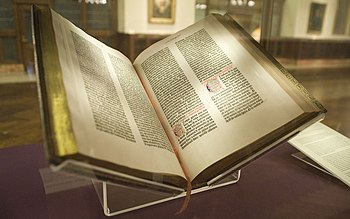However, as I did it off the top of my head, and my memory was not infallible, I did make a few mistakes. For example, I said the invention of the printing press enabled Martin Luther to read the Bible, but as a priest in the church he would have had access to the Bible even without the printing press. Even so, the printing press (movable type) did make the Bible available to those outside of the clergy, and this did have a role in leading to the Reformation. The Gutenberg Bible, printed in the 1450s, was the first major book to be printed with movable type in the West.
Another mistake I made was to state that Constantine had declared Christianity to be the state religion of Rome. Constantine did have an important role to play when he gave Christians the freedom to worship in 313 A.D. It was the Edict of Thessalonica by Theodosius I, Gratian, and Valentinian II in 380 A.D. which determined that
all their subjects should profess the faith of the bishops of Rome
and Alexandria.
This made the Christian Church of the Nicene Creed the official state
religion of the Roman Empire.
Speaking of the Nicene Creed, this was the result of an ecumenical council which met in Nicaea in 325 A.D. Before
the council at Nicaea, there was a lot of controversy over the nature of
the Godhead. One group believed that Jesus was an ordinary man who
became the Christ and Son of God at his baptism; another group taught that in the
role of the Son, God is manifested in the flesh as a human, in order
to bring about the salvation of mankind; and a third group argued the
Father was a superior and distinct being from the Son, and that the
Son was a superior and distinct being from the Holy Spirit. The Council of Nicaea adopted a term for the relationship
between the Father and the Son that from then on was seen as the
hallmark of orthodoxy; it declared that the Son is "of the same
being" as the Father. This was further developed into the
formula "three persons, one being".
If
the Council of Nicaea and the Creed it produced does not demonstrate
why we need continuing and modern revelation, I don’t know what
does.
It might be useful for missionaries to have some understanding of the history, though an in depth knowledge might not be required. I might suggest a little research of the following topics at Wikipedia (as long as you're not writing a college paper, Wiki should be okay).
Constantine the Great and Christianity:
Edict of Thessalonica:
Council of Nicaea:
The Crusades:
The Renaissance:
The Gutenberg Press:
The Gutenberg Bible:
Martin Luther:
The Reformation:
Henry VIII:
The puritans:
Roger Williams

No comments:
Post a Comment